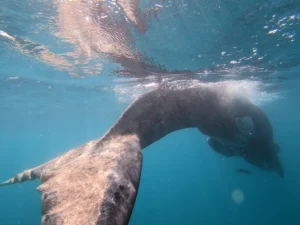If you are reading this article then you are undoubtedly curious about holding your breath. Maybe you have been out snorkeling and wondered about diving down to get a bit closer to a marine creature. Perhaps you’ve tried to hold your breath and are now thinking, “I can hold my breath for 30 seconds, is that a normal breath holding time in adults?” In our experience, the average breath hold time for an adult who has never tried to hold their breath before for an extended period of time is between 30 to 45 seconds. With a few consecutive tries and a lot of self motivation this could be extended to just over 1 minute. After that, most people start to develop an uneasy feeling that maybe they are doing something wrong or dangerous. This is where the experts come in. If you want to know how to hold your breath longer and safely, then the best thing to do is to ask someone who does it for a living. In 2019 our amazing Freediving Master Instructor Trainer, Stephan Kirsten, put together a ‘Lockdown Breath Hold Series’ of videos in which he explains the ins and outs of holding your breath. While these videos are aimed at freedivers or people interested in learning how to freedive, they are equally useful for anyone interested in developing a good breath holding time… even if it is just applied to visits to stinky public toilets.
Episode 1: Breathing for Freediving
In this video Stephan explains freediving breathing techniques. These techniques are used in preparation for breath holds and for recovery from breath holds. Stephan goes into detail regarding how we move air in and out of our bodies, which muscle groups are used for breathing, how to activate breathing muscles in isolation, breathing to induce relaxation, taking in a longer breath and filling the lungs and how to breathe to make recovery from a breath hold safer. If you are serious about learning how to hold your breath longer then don’t skip this video!
Episode 2: Safety Protocols during Static (STA)
Holding your breath for extended periods of time has some potential dangers associated with it. In this video Stephan explains the first rule of freediving “Never freedive or hold your breath on your own.” A partner should always be with you during breath holds to provide support, safety and record your times. There is a significant difference in potential dangers between breath holds done in water and those done on a couch in your living room. Stephan explains what a blackout (passing out) is and explains the stages of hypoxia that precede a blackout. He also goes into how to identify an oncoming blackout and how our bodies react to prevent drowning in water via laryngospasm. Lastly, he goes into safety protocols in case your breath hold partner does blackout.
Episode 3: Static Breath Hold (STA)
Now that you have learnt how to prepare for a breath hold and the safety precautions needed for safe breath holds, this is the video where Stephan explains how to put it all together to achieve a maximum breath holding time. He recaps on preparation breathing, filling up the lungs with the maximum amount of air and then holding your breath. The stages of a breath hold and factors affecting breath holding time are discussed. In particular, Stephan explains the urge to breathe, how a buildup of CO2 in the body increases this response and how using visualisation, body scans, focussing on your surroundings and using numerical targets can help you better deal with your response to elevated CO2 levels. He also delves into abdominal contractions and recovery breathing. Lastly he provides suggestions for a sequence of breath holds that will help you achieve a maximum breath hold. You will quickly progress from a one minute breath hold to holding your breath for 2 minutes or longer!
While online video tutorials are great for learning the basics and for those who do not have access to professional help, they will never replace hands-on instruction from a freediving professional. If you find this series useful then please contact us to find out how to enrol on a Pure Apnea certified freediving course with one of our professional freediving instructors.



